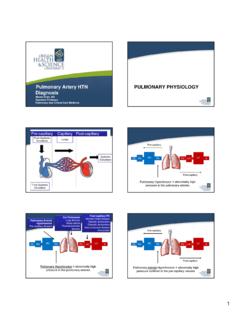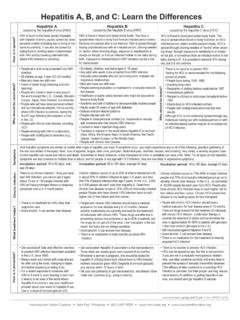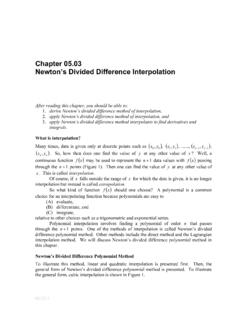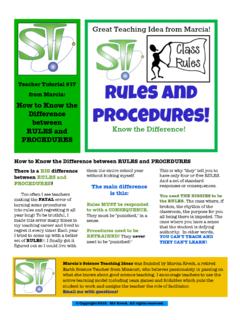Transcription of What’s the difference between PAs and NPs?
1 , NO. 10 OCTOBER 2006 JAAPA 15 Any PA student or practicing PA has undoubtedlybeen asked the question, what is the differencebetween a PA and a nurse practitioner (NP)? There is no easy way to respond because what a PA or an NP does varies by state, specialty, and individual prac-tice. The AAPA Public Relations Committee decided to handle such a question with a list of helpfulresources. Our intent was not to make PAs experts onthe NP profession but rather to inform PAs on whereto find accurate information. In May, we presented theinformation at the AAPA Annual Conference in SanFrancisco; this editorial, along with the accompanyingsidebar, available on the Web, offers an overview ofwhat we , working with a variety of health professionals,must understand the roles of all members of the PAs and NPs provide patient care, preventivecare, and health promotion.
2 However, as one NP writerput it, Although NPs and PAs do similar things, we dothese things in our own way, with a unique philosophy. 1 Loretta Ford, RN, EdD, considered the mother ofthe NP profession, has said, Although confusion stillexists, the NP role is not a medical one we are notphysician assistants or extenders, nor do we offer med-ical services at the MD s command. 2So what is the difference between PAs and NPs? Thebasic differences lie in the areas of education, regula-tion, and the relationship with are more than 300 NP programs; within those pro-grams there are specialty tracks such as family health,pediatric health, and adult is the policy of theAmerican College of Nurse Practitioners that nursepractitioner education must be specific to an area of prac-tice of NPs are trained in a specialtyarea, they may choose to work in a related subspecialtyTammy Ream is Coordinator of Clinical Education and AssistantProfessor, Texas Tech University Health Sciences CenterPhysician Assistant Program, and Immediate Past Chair, AAPAP ublic Relations Committee.
3 Nancy Hughes is Vice President,Communications and Information Services, For example, an NP could be certified as an adulthealth NP or a family health NP. However, with on-the-job clinical training and continuing education, the NP sarea of expertise could be recent additionto NP education is the Doctor of Nursing Practice (DNP)degree, which stresses clinical practice and leadershipgrowth. The American Association of Colleges ofNursing s Web site lists 22 active DNP the PA profession, there are 136 accredited PA pro-grams, and 75% award a master s studentsreceive a general medical education, and all programsare accredited by the Accreditation Review Commissionon Education for the Physician educationfocuses on the competency of the graduate to practicemedicine rather than on the degree nursing literature defines NP regulation in two ways:in some states, the Board of Nursing has sole authority,and in others, physician involvement is necessary forpractice.
4 In 45 states and the District of Columbia, theBoard of Nursing has sole authority in determining scopeof practice for NPs; in five states, the authority is sharedwith the Board of Medicine. However, in 37 states, physi-cian involvement is required in order for the NP to prac-tice to the fullest extent, such as prescribing 2005, 43 states and the District of Columbiarequired NPs to be nationally certified by one of four dif-ferent bodies for purposes of all 50 states, DC, and the US territories, PAs workwith physician supervision. PAs are licensed by the statemedical licensing board, the PA-specific component of themedical board, or a separate PA states and theDistrict of Columbia require PAs to pass the PhysicianAssistant National Certification Examination adminis-tered by the National Commission on Certification ofPhysician Assistants as a condition for with physiciansMost PAs and NPs work at group or solo-physician ,14A sample survey by the American Academy of Nurse Practitioners shows that the most commonGUEST EDITORIALGUEST EDITORIALWhat s the differencebetween PAs and NPs?
5 Tammy Ream, PA-C, MPAS; Nancy Hughes16 JAAPA , NO. 10 OCTOBER 2006 for NPs are family health, adult health,women s health, pediatric health, and geriatric most common specialty areas for PAs are family/general medicine, surgical subspecialties, internal medi-cine subspecialties, emergency medicine, and generalinternal 2004, 62% of NPs in all specialties reported seeingapproximately 3 to 4 patients in an hour, and 27% re-ported seeing 1 to 2 patients an reported they take call. Seventy-one percent ofthe NPs reported having a physician available on sitebetween 45% and 100% of the typical PA who sees inpatients exclusively had amean of 67 patient encounters a week in 2005.
6 The typ-ical PA who sees outpatients exclusively reported amean of 96 patient encounters a week. In addition, 40%of all PA respondents to the 2005 AAPA Census Surveytake call and average 96 call hours per PAs embrace the physician-PA team conceptand physician supervision, NPs generally use the term collaboration, meaning a close working relationshipbetween different professions. That said, NPs do viewthemselves as part of an interdisciplinary health careteam. As one NP editorial writer stated, Early in theNP movement, NPs who were self-employed were saidto be in independent practice. This term was neverproperly defined and led to much confusion and ani-mosity .. No one on that [interdisciplinary] team func-tions independently.
7 18 How that team functions is determined by state lawand the individual practice or hospital. For example,both the American Medical Association and the JointCommission on Accreditation of Healthcare Organiza-tions have considered the chart co-signature have opted for allowing the physician, PA, andinstitution to craft a system at the practice level that isbest for the supervision results in efficient physicianoversight and direction, excellence in the care providedby physician-PA teams, and good use of everyone stime. It also takes into consideration the ability of PAsto make autonomous decisions concerning the care ofthe patient. Physicians rely on PAs to appropriatelyprovide medical care within their knowledge and expe-rience; PAs rely on physicians to be available when acase requires the physician s unique skills.
8 Of course,within this special relationship, PAs exercise autonomyin medical decision-making and provide a broad range ofdiagnostic and therapeutic 47 million people in this country lack adequatehealth average age of the populationalso is increasing, and older people place greater de-mands on the health care system. Restrictions on resi-dent work hours went into effect in 2003. However, hos-pitals still need providers to meet patient and policy makers seek solutions to improveaccess to care, and PAs have proven themselves to be acost-effective way to enhance health care services. CNN and Moneymagazine have proclaimed the PAprofession one of the top ten jobs in the country, and theBureau of Labor Statistics projects it will be the fourthfastest-growing profession between 2004 and ,23 But it will take more than PAs for the health care sys-tem to accommodate growing demands.
9 It will take arespected team of providers with different skills, dif-ferent methods of providing care, and different philoso-phies, but the same commitment to helping patients. As members of the health care family, PAs and NPsaren t better or worse than one another. They re justdifferent. They and various other providers are allneeded to enhance the delivery of care. REFERENCES1. Bartol T. NPs are not physician substitutes. Am J Nurse Pract. 2006;10(6) Ford LC. From NPs founding mother, Dr. Loretta C. Ford. Nurse Pract World ;10(3) US Department of Health and Human Services. Health Resources and ServicesAdministration. Bureau of Health Professions. A comparison of changes in the pro-fessional practice of nurse practitioners, physician assistants, and certified nursemidwives: 1992 and 2000.
10 Available at: Accessed September 7, 2006. 4. American College of Nurse Practitioners (ACNP). Position statement on nurse prac-titioner education. Available at: September 7, 2006. 5. Beard A, American College of Nurse Practitioners. Private e-mail 14, American Association of Colleges of Nursing. Doctor of Nursing Practice at: AccessedSeptember 7, 2006. 7. American Academy of Physician Assistants. Facts at a glance. Available at: Accessed September 7, Accreditation Review Commission on Education for the Physician Assistant. Availableat: Accessed September 7, Phillips S. 18th Annual legislative update. Nurse Pract. 2006;31(1) Towers J. After forty years. J Am Acad Nurse Pract.









![Dif In Dif Slides.ppt [Repaired] - Wharton Finance](/cache/preview/e/2/9/5/4/6/1/8/thumb-e29546186543c246a2365bc5cbc8c9a4.jpg)
